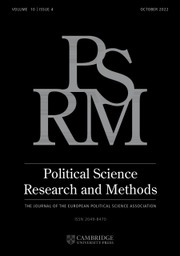Article contents
Every Story Has a Beginning, Middle, and an End (But Not Alwaysin That Order): Predicting Duration Dynamics in a Unified Framework*
Published online by Cambridge University Press: 11 March 2015
Abstract
There are three fundamental duration dynamics of civil conflicts: time untilconflict onset, conflict duration, and time until conflict recurrence.Theoretical and empirical models of war usually focus on one or at most twoaspects of these three important duration dynamics. We present a newsplit-population seemingly unrelated duration estimator that treatspre-conflict duration, conflict duration, and post-conflict duration asinterdependent processes thus permitting improved predictions about theonset, duration, and recurrence of civil conflict. Our findings providesupport for the more fundamental idea that prediction is dependent on a goodapproximation of the theoretically implied underlying data-generatingprocess. In addition, we account for the fact that some countries mightnever experience these duration dynamics or become immune after experiencingthem in the past.
Information
- Type
- Original Articles
- Information
- Copyright
- © The European Political Science Association 2015
Footnotes
Daina Chiba, Lecturer, Department of Government, University of Essex,Colchester, CO4 3SQ (dchiba@essex.ac.uk). Nils W. Metternich, Lecturer,Department of Political Science, University College London, London,WC1H 9QU (n.metternich@ucl.ac.uk).Michael D. Ward, Professor, Department of Political Science, DukeUniversity, Durham, NC 27708 (michael.d.ward@duke.edu). This projectwas undertaken in the framework of an initiative funded by theInformation Processing Technology Office of the Defense AdvancedResearch Projects Agency aimed at producing models to provide anIntegrated Crisis Early Warning Systems (ICEWS) for decision makers inthe US defense community. The holding grant is to the Lockheed MartinCorporation, Contract FA8650-07-C-7749. Earlier versions of the paperhave been presented at the joint meetings of the Conflict ResearchSociety and European Network for Conflict Research, September 17–20,2013; the Asian Political Methodology Meeting, January 6–7, 2014,Tokyo; and the UCL Departmental Research Seminar, February 12, 2014.The authors are grateful for the helpful comments they received duringand after these presentations. They would also like to thank AndreasBeger, Kentaro Fukumoto, Julian Wucherpfennig, and members of the WardLab at Duke University for helpful comments. Nils W. Metternichacknowledges support from the Economic and Social Research Council(ES/L011506/1).
References
- 18
- Cited by

